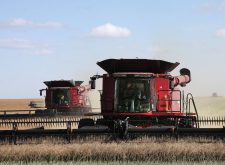(REUTERS) — Patchy weekend rains in Argentina’s parched northern grain belt have left many growing areas in a difficult situation, a local meteorologist said.
In some areas the rains brought moisture to wheat fields and helped corn planting which has been delayed, both for 2013—14 season crops. But in other areas wheat continues to deteriorate while corn will either lose planted area to soy or be planted late, meteorologist German Heinzenknecht of local consultancy Applied Climatology said.
More rain is forecast for the northern part of the grains area beginning next week, he said.
Read Also

B.C. ostriches culled, CFIA confirms
Ostriches on an embattled Edgewood, B.C. farm have been culled after a prolonged legal battle, the Canadian Food Inspection Agency has confirmed.
The South American grain powerhouse is the world’s No. 3 corn exporter and a big wheat supplier at a time of rising global demand.
“It rained widely between Friday and Monday (in the northern portions of Argentina’s grain belt), but (that rain) was very patchy,” Heinzenknecht said. “Some fields were in very good shape and others remained practically as they were before.”
The rains were significant in southern Cordoba province and western Entre Rios province, while in the south and centre of the Santa Fe province rains were scarce, he added.
“Except for the areas that received between 30 and 40 millimeters, I don’t think that anyone planted corn on those days. They are going to be delayed to (December) or people will plant soy,” Heinzenknecht said.
Soy is not only more weather tolerant than corn, it costs less to grow and is exempt from the export curbs that the government puts on corn and wheat.
For 2013-14 wheat, he pointed out that the regions that received abundant rain in recent days could compensate for a drop in yields by producing a high-quality crop.
The Buenos Aires Grains Exchange estimates the 2013-14 wheat harvest to reach 10.35 million tonnes and that 8.6 million acres will be planted with commercial use corn in the current season, below the nine million acres planted in the 2012-13 season.
Meanwhile, in the centre and southern growing regions, made up in large part by the province of Buenos Aires, crops are in better condition because they received more rain.
“In the north of Buenos Aires the situation is better, although its still not ideal,” Heinzenknecht said, adding that in the centre and south of the province, where nearly half of Argentine wheat is concentrated, crops are doing very well.
Nevertheless, the meteorologist warned of possible frosts at the beginning of next week close to the heart of the Argentine wheat belt.
“We expect some frost on Monday or Tuesday of next week,” Heinzenknecht said, though he added that it will be unlikely to damage the crop.














